Acyl-Nω-methylserotonins and Branched-chain Acylserotonins in Lemon and Other Citrus Seeds—New Lipids with Antioxidant Properties and Potential Pharmacological Applications
Abstract
1. Introduction
2. Materials and Methods
2.1. Plant Material and Chemicals
2.2. Extraction and Purification Procedure
2.3. Fluorescence Spectra
2.4. Mass Spectrometry
2.5. Synthesis of N-acylserotonins
2.6. Hydrolysis of N-acylserotonins and Lipids of Lemon Seed Oil
2.7. Quantitative Determination of Individual Compounds in Seeds
2.8. Determination of the Reaction Rate Constants with DPPH
3. Results
3.1. Identification of the Extract Components
3.2. Composition of N-acylserotonins in Seeds of Different Lemon Varieties and Other Citrus Species
3.3. Antioxidant Activity of N-acylserotonins
4. Discussion
Supplementary Materials
Author Contributions
Funding
Data Availability Statement
Acknowledgments
Conflicts of Interest
Abbreviations
| DPPH | 2,2-diphenyl-1-picrylhydrazyl |
| EDC | N-(3-dimethylaminopropyl)-N′-ethylcarbodiimide hydrochloride |
| THF | tetrahydrofuran |
| DMF | dimethylformamid |
| HOBT | 1-hydroxybenzotriazole hydrate |
| FW | fresh weight |
| Ser | serotonin |
References
- Seppanen, C.M.; Song, Q.; Saari Csallany, A. The antioxidant functions of tocopherol and tocotrienol homologues in oils, fats, and food systems. J. Am. Oil Chem. Soc. 2010, 87, 469–481. [Google Scholar] [CrossRef]
- Kruk, J.; Szymańska, R.; Cela, J.; Munne-Bosch, S. Plastochromanol-8: Fifty years of research. Phytochemistry 2014, 108, 9–16. [Google Scholar] [CrossRef] [PubMed]
- Szymańska, R.; Nowicka, B.; Kruk, J. Vitamin E—Occurrence, biosynthesis by plants and functions in human nutrition. Mini-Rev. Med. Chem. 2017, 17, 1039–1052. [Google Scholar] [CrossRef] [PubMed]
- Hicks, K.B.; Moreau, R.A. Phytosterols and Phytostanols: Functional food cholesterol busters. Food Technol. 2001, 55, 63–69. [Google Scholar]
- Kritchevsky, D.; Chen, S.C. Phytosterols-health benefits and potential concerns: A review. Nutr. Res. 2005, 25, 413–428. [Google Scholar] [CrossRef]
- Goufo, P.; Trindade, H. Rice antioxidants: Phenolic acids, flavonoids, anthocyanins, proanthocyanidins, tocopherols, tocotrienols, c-oryzanol, and phytic acid. Food Sci. Nutr. 2014, 2, 75–104. [Google Scholar] [CrossRef]
- Qureshi, A.A.; Mo, H.; Packer, L.; Peterson, D.M. Isolation and identification of novel tocotrienols from rice bran with hypocholesterolemic, antioxidant, and antitumor properties. J. Agric. Food Chem. 2000, 48, 3130–3140. [Google Scholar] [CrossRef]
- Hotta, Y.; Nagatsu, A.; Liu, W.; Muto, T.; Narumiya, C.; Lu, X.; Yajima, M.; Ishikawa, N.; Miyazeki, K.; Kawai, N.; et al. Protective effects of antioxidative serotonin derivatives isolated from safflower against postischemic myocardial dysfunction. Mol. Cell. Biochem. 2002, 238, 151–162. [Google Scholar] [CrossRef]
- Theriault, A.; Chao, J.T.; Wang, Q.; Gapor, A.; Adeli, K. Tocotrienol: A review of its therapeutic potential. Clin. Biochem. 1999, 32, 309–319. [Google Scholar] [CrossRef]
- Cicero, A.F.G.; Gaddi, A. Rice bran oil and γ-oryzanol in the treatment of hyperlipoproteinaemias and other conditions. Phyther. Res. 2001, 15, 277–289. [Google Scholar] [CrossRef]
- Trela-Makowej, A.; Kruk, J.; Jemioła-Rzemińska, M.; Szymańska, R. Acylserotonins—A new class of plant lipids with antioxidant activity and potential pharmacological applications. Biochim. Biophys. Acta-Mol. Cell Biol. Lipids. 2021, 1866, 159044. [Google Scholar] [CrossRef]
- Fragata, M.; Bellemare, F. Micropolarities of lipid bilayers and micelles: II. Application limits of dielectric constant determinations with the polarity probe α-tocopherol. J. Colloid Interface Sci. 1980, 77, 243–252. [Google Scholar] [CrossRef]
- Kruk, J.; Schmid, G.H.; Strzalka, K. Antioxidant properties of plastoquinol and other biological prenylquinols in liposomes and solution. Free Radic. Res. 1994, 21, 409–416. [Google Scholar] [CrossRef]
- Nordby, H.E.; Nagy, S. Fatty acid profiles of citrus juice and seed lipids. Phytochemistry 1969, 8, 2027–2038. [Google Scholar] [CrossRef]
- Weitkamp, A.W. The Acidic Constituents of Degras. A New Method of Structure Elucidation. J. Am. Chem. Soc. 1945, 67, 447–454. [Google Scholar] [CrossRef]
- Mukai, K.; Morimoto, H.; Kikuchi, S.; Nagaoka, S. Kinetic study of free-radical-scavenging action of biological hydroquinones (reduced forms of ubiquinone, vitamin K and tocopherol quinone) in solution. BBA-Gen. Subj. 1993, 1157, 313–317. [Google Scholar] [CrossRef]
- Ramakrishna, A.; Giridhar, P.; Ravishankar, G.A. Phytoserotonin: A review. Plant Signal. Behav. 2011, 6, 800–809. [Google Scholar] [CrossRef]
- Erland, L.A.E.; Turi, C.E.; Saxena, P.K. Serotonin: An ancient molecule and an important regulator of plant processes. Biotechnol. Adv. 2016, 34, 1347–1361. [Google Scholar] [CrossRef]
- Smith, T.A. Tryptamine and related compounds in plants. Phytochemistry 1977, 16, 171–175. [Google Scholar] [CrossRef]
- Powell, S.L.; Godecke, T.; Nikolic, D.; Chen, S.-N.; Ahn, S.; Dietz, B.; Farnsworth, N.R.; Van Breemen, R.B.; Lankin, D.; Pauli, G.F.; et al. In vitro serotonergic activity of black cohosh and identification of N ω-methylserotonin as a potential active constituent. J. Agric. Food Chem. 2008, 56, 11718–11726. [Google Scholar] [CrossRef]
- Servillo, L.; Giovane, A.; Balestrieri, M.L.; Casale, R.; Cautela, D.; Castaldo, D. Citrus genus plants contain N-methylated tryptamine derivatives and their 5-hydroxylated forms. J. Agric. Food Chem. 2013, 61, 5156–5162. [Google Scholar] [CrossRef]
- Servillo, L.; Giovane, A.; Casale, R.; D’Onofrio, N.; Ferrari, G.; Cautela, D.; Balestrieri, M.L.; Castaldo, D. Serotonin 5-O-β-glucoside and its N-methylated forms in Citrus genus plants. J. Agric. Food Chem. 2015, 63, 4220–4227. [Google Scholar] [CrossRef]
- Yanase, E.; Ohno, M.; Harakawa, H.; Nakatsuka, S.I. Isolation of N,N-dimethyl and N-methylserotonin 5-0-ß-glucosides from immature zanthoxylum piperitum seeds. Biosci. Biotechnol. Biochem. 2010, 74, 1951–1952. [Google Scholar] [CrossRef] [PubMed]
- Kaneda, T. Iso- and anteiso-fatty acids in bacteria: Biosynthesis, function, and taxonomic significance. Microbiol. Rev. 1991, 55, 288–302. [Google Scholar] [CrossRef]
- Taormina, V.M.; Unger, A.L.; Schiksnis, M.R.; Torres-Gonzalez, M.; Kraft, J. Branched-chain fatty acids—An underexplored class of dairy-derived fatty acids. Nutrients 2020, 12, 2875. [Google Scholar] [CrossRef]
- Wolff, R.L.; Pédrono, F.; Pasquier, E.; Marpeau, A.M. General characteristics of Pinus spp. seed fatty acid compositions, and importance of Δ5-olefinic acids in the taxonomy and phylogeny of the genus. Lipids 2000, 35, 1–22. [Google Scholar] [CrossRef]
- PlantFAdb. Available online: https://plantfadb.org (accessed on 14 September 2022).
- Baker, E.A.; Procopioua, J.; Hunt, G.M. The Cuticles of Citrus Species. Composition of Leaf and Fruit Waxes. J. Sci. Fd Agric. 1975, 26, 1093–1101. [Google Scholar] [CrossRef]
- Ismaiel, A.M.; Glennon, R.A.; Titeler, M.; Miller, K.J.; Smith, T.S. 5-HT1and 5-HT2Binding Profiles of the Serotonergic Agents α-Methylserotonin and 2-Methylserotonin. J. Med. Chem. 1990, 33, 755–758. [Google Scholar] [CrossRef]
- Glennon, R.A.; Young, R.; Dukat, M. 5-HT3 agonist 2-methylserotonin as a training drug in drug discrimination studies. Pharmacol. Biochem. Behav. 1992, 41, 361–364. [Google Scholar] [CrossRef]
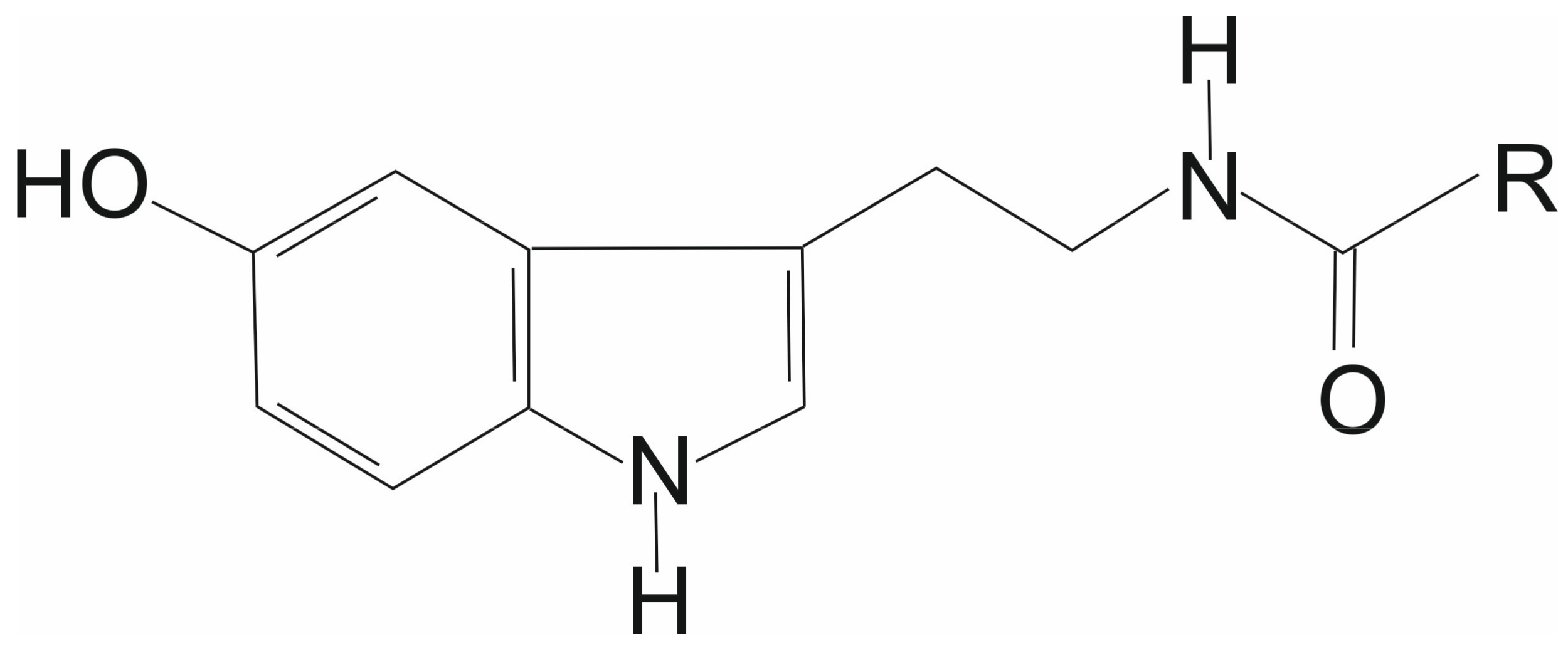
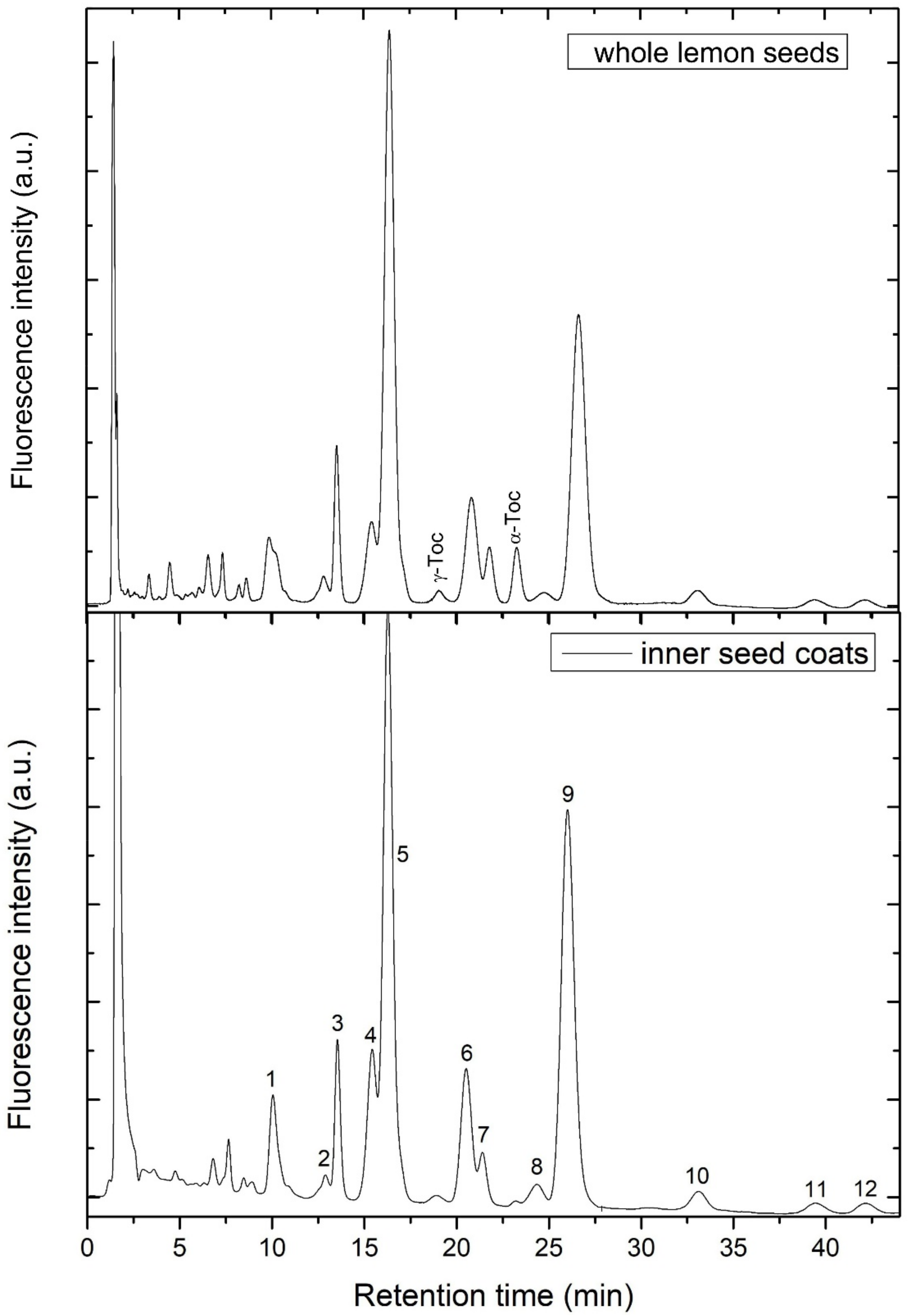
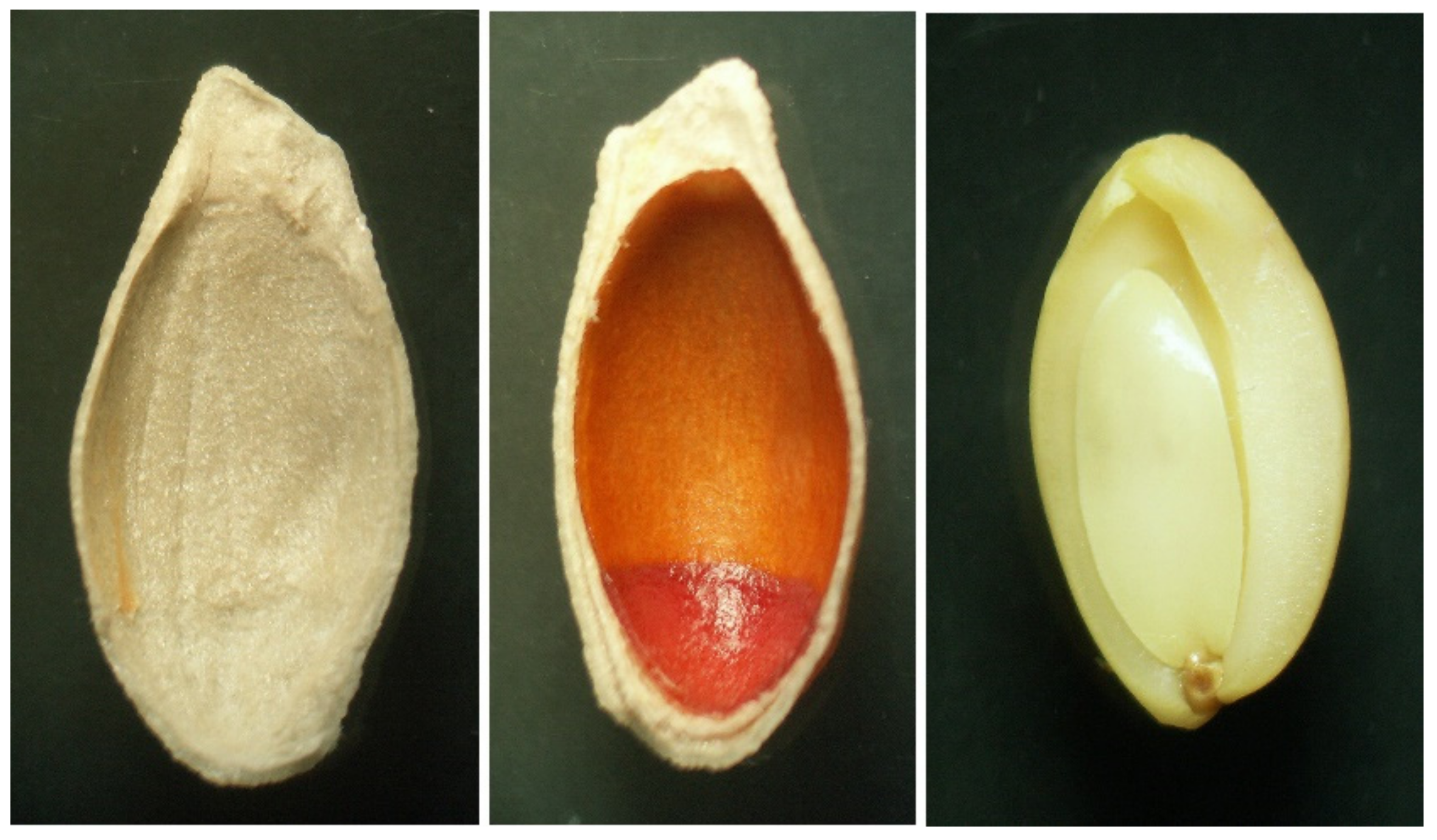
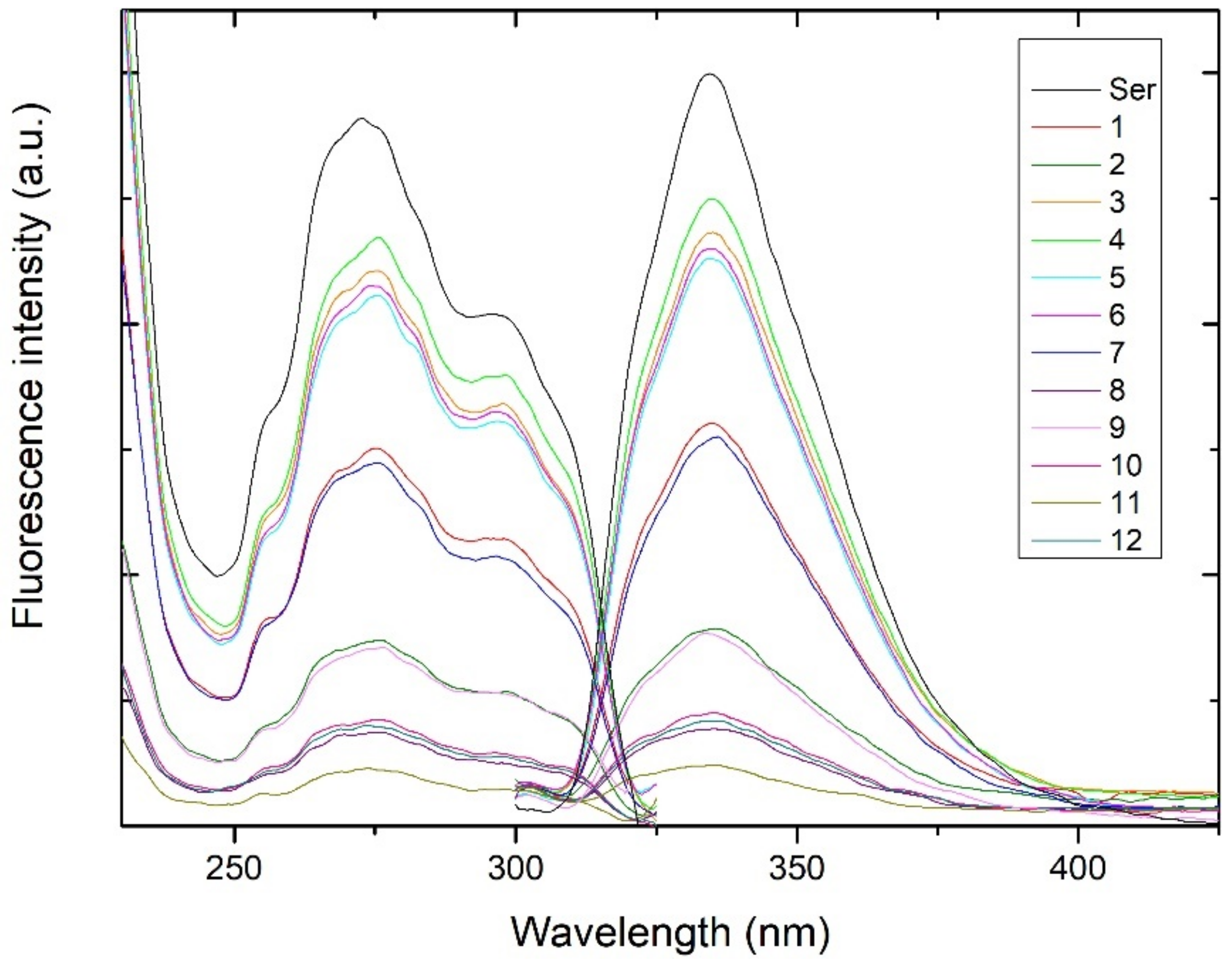
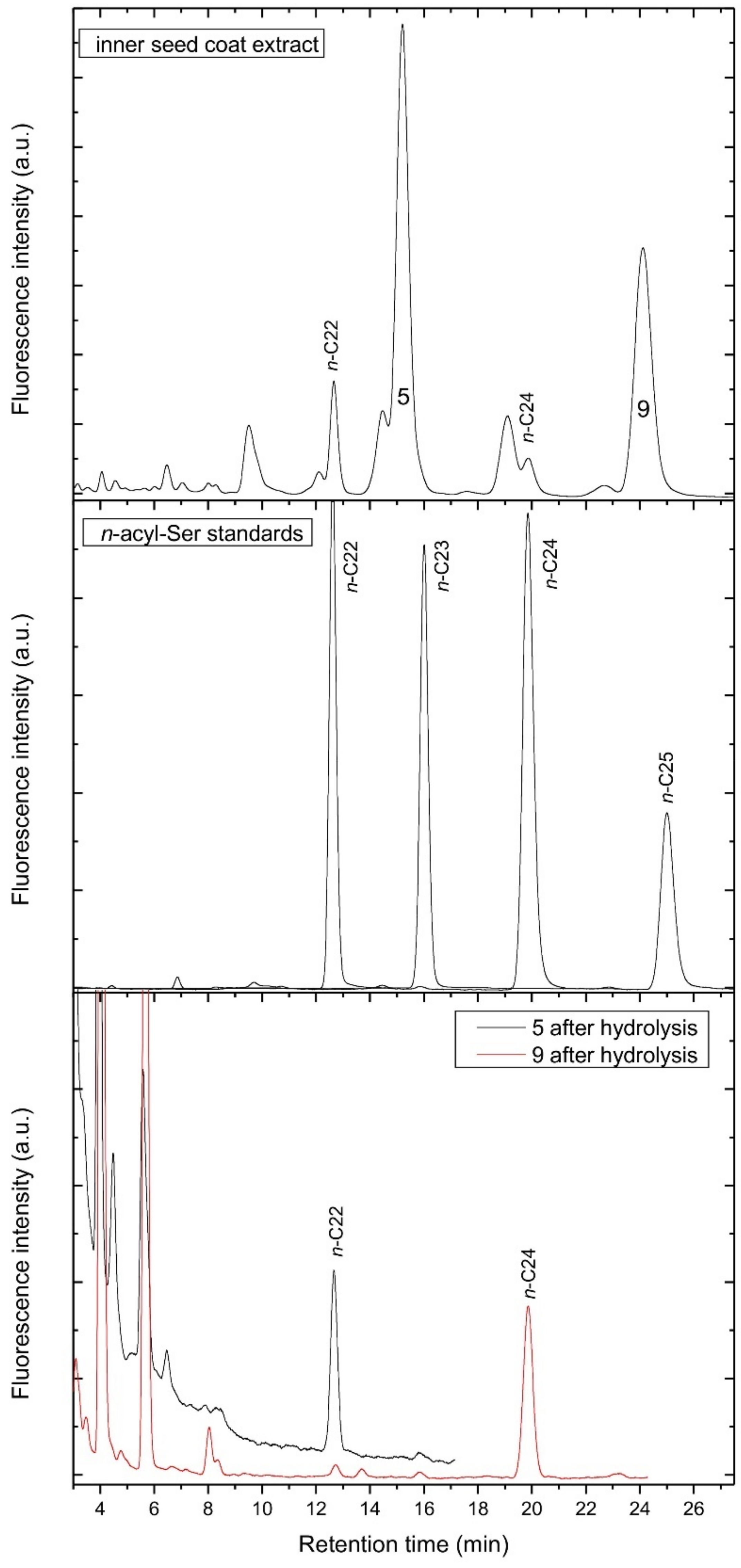
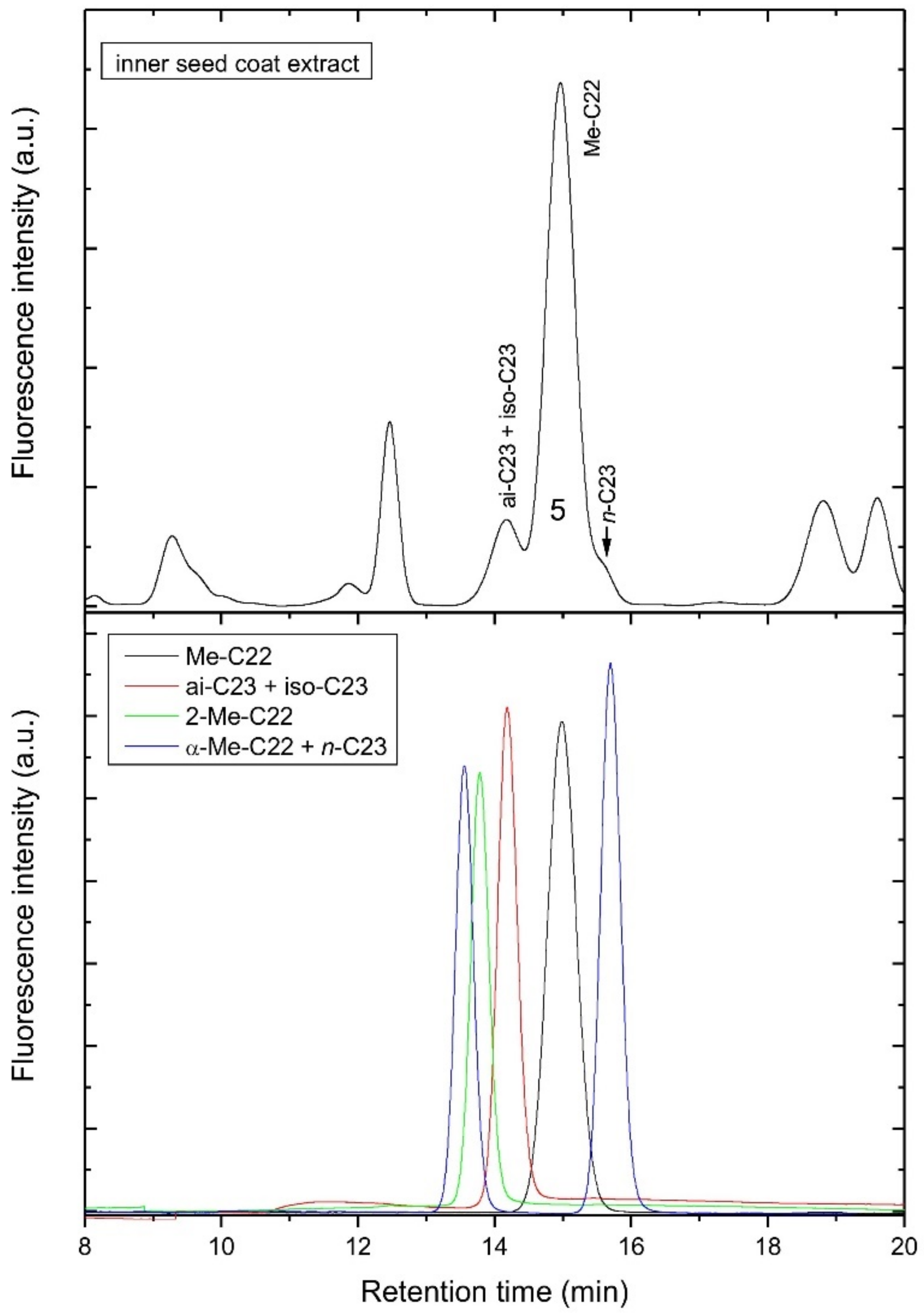

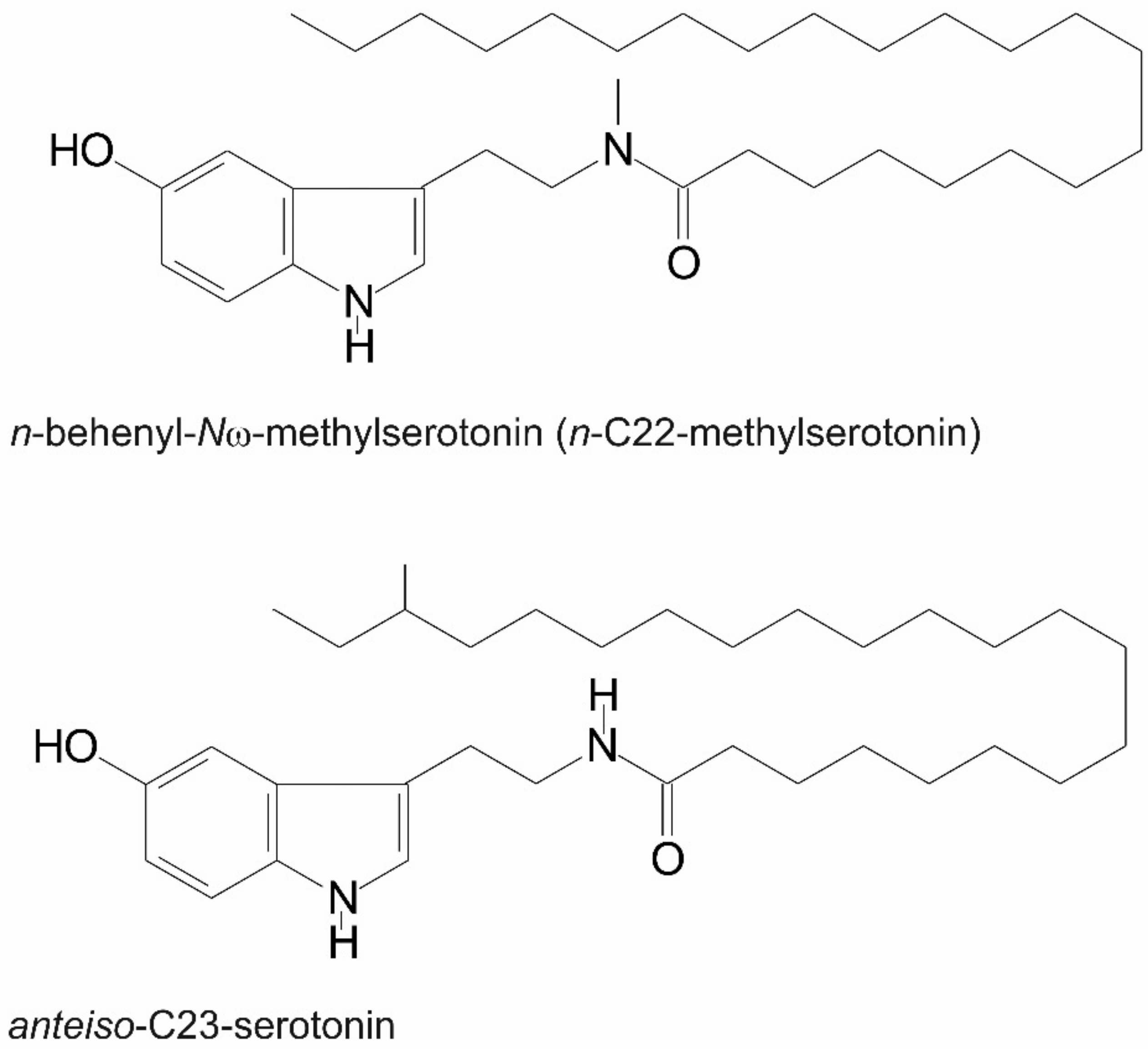
| Peak Number | Fluorescence Maxima (nm) | HR–MS (m/z) | Molecular Formula | Exact Mass | Δ (mDa) | Corresponding Structure | |
|---|---|---|---|---|---|---|---|
| Excitation | Emission | ||||||
| 1 | 275, 298 sh | 335 | 507.3921 | C31H52N2O2Na+ | 507.3921 | 0.0 | C21-Ser |
| 2 | 275, 298 sh | 335 | 521.4081 | C32H54N2O2Na+ | 521.4078 | 0.3 | C22-Ser |
| 3 | 275, 298 sh | 335 | 521.4073 | C32H54N2O2Na+ | 521.4078 | 0.5 | C22-Ser |
| 4 | 275, 298 sh | 335.5 | 535.4235 | C33H56N2O2Na+ | 535.4234 | 0.1 | C23-Ser |
| 5 | 275, 298 sh | 335 | 535.4227 | C33H56N2O2Na+ | 535.4234 | 0.7 | C23-Ser |
| 6 | 274.5, 298 sh | 335 | 549.4384 | C34H58N2O2Na+ | 549.4391 | 0.7 | C24-Ser |
| 7 | 275, 298 sh | 335.5 | 549.4386 | C34H58N2O2Na+ | 549.4391 | 0.5 | C24-Ser |
| 8 | 275, 298 sh | 335 | 563.4563 | C35H60N2O2Na+ | 563.4547 | 1.6 | C25-Ser |
| 9 | 275, 298 sh | 334 | 563.4557 | C35H60N2O2Na+ | 563.4547 | 1.0 | C25-Ser |
| 10 | 275, 298 sh | 335 | 577.4699 | C36H62N2O2Na+ | 577.4704 | 0.5 | C26-Ser |
| 11 | 274.5, 298.5 sh | 335 | 591.4872 | C37H64N2O2Na+ | 591.4860 | 1.2 | C27-Ser |
| 12 | 274, 298 sh | 335 | 591.4857 | C37H64N2O2Na+ | 591.4860 | 0.3 | C27-Ser |
| Acylserotonin | Turkey/‘Lamas’ | Italy/‘Primaflora’ | Spain/‘Verna’ |
|---|---|---|---|
| <C21 | 2.3 | 1.7 | 2.9 |
| ai-C21 | 3.3 | 0.8 | 0.7 |
| Me-C20 | 2.2 | 1.0 | 0.4 |
| n-C21 | n.d. | n.d. | 0.3 |
| Me-C21 | 1.1 | 0.75 | 1.9 |
| n-C22 | 6.0 | 2.25 | 20.7 |
| ai-C23 | 5.8 | 3.1 | 3.7 |
| Me-C22 | 38.6 | 42.8 | 14.3 |
| n-C23 | n.d. | n.d. | 4.3 |
| Me-ai-C23 | 0.2 | 0.4 | n.d. |
| Me-C23 | 7.1 | 8.8 | 3.7 |
| n-C24 | 2.8 | 1.8 | 16.6 |
| ai-C25 | 0.8 | 0.6 | 0.5 |
| Me-C24 | 26.8 | 31.0 | 21.2 |
| n-C25 | n.d. | n.d. | 1.1 |
| iso-C26 | n.d. | 0.14 | n.d. |
| Me-C25 | 1.1 | 2.0 | 1.9 |
| n-C26 | n.d. | 0.08 | 1.2 |
| ai-C27 | 1.0 | 0.6 | 1.0 |
| Me-C26 | 0.9 | 1.9 | 2.5 |
| n-C27 | n.d. | n.d. | 0.1 |
| iso-C28 | n.d. | 0.2 | 0.2 |
| Me-C27 | n.d. | 0.04 | 0.2 |
| n-C28 | n.d. | n.d. | 0.4 |
| total acyl-Me-Sers (%) | 77.8 | 88.3 | 45.1 |
| total n-acyl-Sers (%) | 8.8 | 4.1 | 44.7 |
| total acyl-Sers mg/g FW | 1.15 ± 0.16 | 1.54 ± 0.32 | 1.02 ± 0.24 |
| Acylserotonin | Tangerine | Grapefruit | Pomelo |
|---|---|---|---|
| <C21 | 2.7 | 2.8 | 2.1 |
| ai-C21 | 1.3 | 1.3 | 1.5 |
| Me-C20 | 1.1 | 1.0 | n.d. |
| n-C21 | 0.1 | n.d. | 0.1 |
| Me-C21 | 0.6 | 0.7 | 0.3 |
| n-C22 | 3.3 | 4.1 | 18.5 |
| ai-C23 | 3.6 | 3.1 | n.d. |
| Me-C22 | 40.5 | 36.1 | 14.6 |
| n-C23 | n.d. | 1.1 | 6.8 |
| Me-C23 | 9.7 | 9.8 | 6.0 |
| n-C24 | 4.3 | 3.7 | 21.8 |
| ai-C25 | n.d. | 0.9 | n.d. |
| Me-C24 | 29.0 | 30.5 | 22.5 |
| n-C25 | n.d. | 1.1 | 2.1 |
| iso-C26 | n.d. | n.d. | n.d. |
| Me-C25 | 3.1 | 2.6 | 1.3 |
| n-C26 | 0.5 | 0.3 | 1.0 |
| ai-C27 | n.d. | 0.8 | 1.3 |
| total acyl-Me-Sers (%) | 83.0 | 81.6 | 44.7 |
| total n-acyl-Sers (%) | 8.2 | 10.3 | 50.3 |
| Compound | Hexane | Acetonitrile | ||
|---|---|---|---|---|
| t1/2 (s) | k (10−3 s−1) | t1/2 (s) | k (10−3 s−1) | |
| α-Toc * | 11.2 ± 0.7 | 61.6 ± 4.1 | 22.0 ± 1.0 | 31.6 ± 1.4 |
| δ-Toc | 26.5± 0.5 | 26.1 ± 0.6 | 268.0 ± 12.0 | 2.6 ± 0.1 |
| n-C22 * | 27.5 ± 3.0 | 25.2 ± 2.7 | 328 ± 114 | 2.1 ± 0.7 |
| n-C24 * | 28.0 ± 2.5 | 24.7 ± 2.2 | 183 ± 12 | 3.7 ± 0.2 |
| Me-C22 | 38.0 ± 2.0 | 18.2 ± 0.9 | 404 ± 12 | 1.7 ± 0.1 |
| Me-C24 | 43.5 ± 1.5 | 15.9 ± 0.6 | 268 ± 16 | 2.6 ± 0.2 |
| iso-C21 | 25.1 ± 0.4 | 27.6 ± 0.4 | 366 ± 10 | 1.9 ± 0.1 |
| iso-C25 | 17.0 ± 0.6 | 40.8 ± 1.4 | 414 ± 30 | 1.6 ± 0.1 |
Publisher’s Note: MDPI stays neutral with regard to jurisdictional claims in published maps and institutional affiliations. |
© 2022 by the authors. Licensee MDPI, Basel, Switzerland. This article is an open access article distributed under the terms and conditions of the Creative Commons Attribution (CC BY) license (https://creativecommons.org/licenses/by/4.0/).
Share and Cite
Kruk, J.; Trela-Makowej, A.; Szymańska, R. Acyl-Nω-methylserotonins and Branched-chain Acylserotonins in Lemon and Other Citrus Seeds—New Lipids with Antioxidant Properties and Potential Pharmacological Applications. Biomolecules 2022, 12, 1528. https://doi.org/10.3390/biom12101528
Kruk J, Trela-Makowej A, Szymańska R. Acyl-Nω-methylserotonins and Branched-chain Acylserotonins in Lemon and Other Citrus Seeds—New Lipids with Antioxidant Properties and Potential Pharmacological Applications. Biomolecules. 2022; 12(10):1528. https://doi.org/10.3390/biom12101528
Chicago/Turabian StyleKruk, Jerzy, Agnieszka Trela-Makowej, and Renata Szymańska. 2022. "Acyl-Nω-methylserotonins and Branched-chain Acylserotonins in Lemon and Other Citrus Seeds—New Lipids with Antioxidant Properties and Potential Pharmacological Applications" Biomolecules 12, no. 10: 1528. https://doi.org/10.3390/biom12101528
APA StyleKruk, J., Trela-Makowej, A., & Szymańska, R. (2022). Acyl-Nω-methylserotonins and Branched-chain Acylserotonins in Lemon and Other Citrus Seeds—New Lipids with Antioxidant Properties and Potential Pharmacological Applications. Biomolecules, 12(10), 1528. https://doi.org/10.3390/biom12101528






